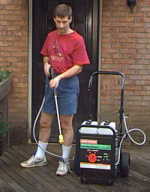Search engine visitors - click here to access entire "$ensible Home" web site
Click here to see a descriptive illustration showing several design of residential pressure washers.
Dear Jim: I'm considering getting a small high pressure washer to use on my house, deck, driveway, windows, car, etc. Do the small lightweight models clean well and do they cost much in water and electricity use? - R. V.

A: There are many designs of small electric and gasoline-powered pressure washers that are ideal for many tasks around the house. There is even a new hand-held mini-rechargeable battery model just for cleaning windows. Using a high pressure washer can cost less overall than using just a hose. The water savings alone is up to 80 percent. For the short time you need to use it as compared to a hose, the electricity costs are not significant.
Also deep cleaning your deck and driveway, for example, increases their lives and reduces costly maintenance. Pressure washing a house before painting can add years to the life of the new paint and eliminate peeling. Professional painters almost always pressure wash first.
Cleaning power of various pressure washers can be compared by multiplying the water pressure (psi) by the water flow (gallons per minute - gpm). The smallest models (some with shoulder straps) operate at 1,100 psi and 1.2 gpm. High-powered gasoline models on carts operate at 3,000 psi and 5.0 gpm.
When selecting the proper pressure washer, consider how you plan to use it. This determines the cleaning power and optional attachments required. The smallest electric ones weigh less than 15 pounds and have a 20-foot hose. A convenience feature is a power switch built into the nozzle trigger.
An adjustable spray attachment is a good idea for most cleaning jobs. Sliding a collar on the handle adjusts the pressure from high to low (used when applying a cleaning solution). Rotating the collar adjusts the spray pattern from a narrow pencil jet to a wide 20-degree fan spray.
For tough cleaning jobs, attach a rotating pencil jet nozzle. The pencil jet rapidly rotates to clean more area using less water and electricity. Brush accessories are often helpful even with the high pressure spray. These mount on the end of the spray wand. An automatic rotating brush can speed cleaning. The water flow itself causes the brush to rotate.
Various manufacturers offer liquid cleaner injection accessories. These automatically feed in the proper amount of general cleaner, degreaser, car wash and wax, etc. Some have variable settings to control the concentration. The mini-rechargeable window washer pumps out a cleaner on to a soft scrubbing wand. The other squeegee edge vacuums the dirty water off the glass.
Instant Download Update Bulletin No. 770 - buyer's guide of 30 home-use pressure washers listing cleaning power, accessories, operating costs, weights, prices and pressure washing tips.
Dear Jim: When I read books about energy conservation, I often come across the term "thermal bridge". From the context, I assume that it is not good. What is a thermal bridge? - R. T.
A: You are right. A thermal bridge is not good. The term refers to a gap in the insulation envelope around the living area of a house. For example, wood studs inside an insulated wall are thermal bridges. Heat readily flows through them as compared to through fiberglass insulation.
A thermal break, a gap in a heat transfer path, is good. An example is a vinyl strip separating the indoor and outdoor aluminum window frame halves.